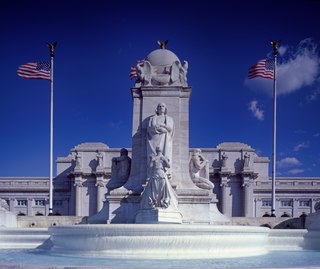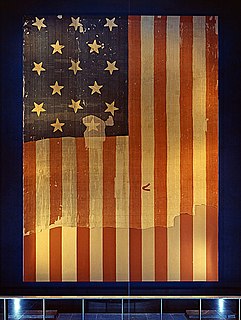
Albert Sidney Johnston served as a general in three different armies: the Texian Army, the United States Army, and the Confederate States Army. He saw extensive combat during his 34-year military career, fighting actions in the Black Hawk War, the Texas War of Independence, the Mexican–American War, the Utah War, and the American Civil War.

William Howard Taft was the 27th president of the United States (1909–1913) and the tenth chief justice of the United States (1921–1930), the only person to have held both offices. Taft was elected president in 1908, the chosen successor of Theodore Roosevelt, but was defeated for reelection in 1912 by Woodrow Wilson after Roosevelt split the Republican vote by running as a third-party candidate. In 1921, President Warren G. Harding appointed Taft to be chief justice, a position he held until a month before his death.

Columbus Fountain also known as the Columbus Memorial is a public artwork by American sculptor Lorado Taft, located at Union Station in Washington, D.C., United States. A centerpiece of Columbus Circle, Columbus Fountain serves as a tribute to the explorer Christopher Columbus. The unveiling in 1912 was celebrated all over Washington, DC over the course of three days with parades, concerts and fireworks gathering tens of thousands of people from all over the world.

William Henry Lewis was an African-American pioneer in athletics, law and politics. Born in Virginia to freedmen, he graduated from Amherst College in Massachusetts, where he had been one of the first African-American college football players. After going to Harvard Law School and continuing to play football, Lewis was the first African American in the sport to be selected as an All-American.

The Second Occupation of Cuba by United States military forces, officially the Provisional Government of Cuba, lasted from September 1906 to February 1909.

The following events occurred in December 1912:
The 1950 State of the Union Address was given by Harry S. Truman, the 33rd president of the United States, on Wednesday, January 4, 1950. He spoke to the 81st United States Congress, to the United States House of Representatives and the United States Senate. It was a joint session, and the 160th address given. He said, "Our aim for a peaceful, democratic world of free peoples will be achieved in the long run, not by force of arms, but by an appeal to the minds and hearts of men." He also said, Our Social Security System should be developed into the main reliance of our people for basic protection against the economic hazards of old-age, unemployment, and illness.
The 1929 State of the Union Address was given by Herbert Hoover, the 31st United States President on Tuesday, December 3, 1929, to both houses of the 71st United States Congress. This is the first State of the Union Address that Herbert Hoover would give to the Congress, and the 1929 Stock Market Crash had just begun. He said,
The 1930 State of the Union Address was given by the 31st United States president, Herbert Hoover, on Tuesday, December 2, 1930. Soon the Great Depression began, and many people became poor. It was his second State of the Union Address to the 71st United States Congress. Key passages:
The 1914 State of the Union Address was given by Woodrow Wilson, the 28th United States president, on Tuesday, December 8, 1914, to both houses of 63rd United States Congress. He concluded it with, "To develop our life and our resources; to supply our own people, and the people of the world as their need arises, from the abundant plenty of our fields and our marts of trade to enrich the commerce of our own States and of the world with the products of our mines, our farms, and our factories, with the creations of our thought and the fruits of our character,-this is what will hold our attention and our enthusiasm steadily, now and in the years to come, as we strive to show in our life as a nation what liberty and the inspirations of an emancipated spirit may do for men and for societies, for individuals, for states, and for mankind."
The 1906 State of the Union Address was written by Theodore Roosevelt, the 26th president of the United States, on Monday, December 3, 1906. He did not speak directly to the 59th United States Congress. He said, "The readiness and efficiency of both the Army and Navy in dealing with the recent sudden crisis in Cuba illustrate afresh their value to the Nation. This readiness and efficiency would have been very much less had it not been for the existence of the General Staff in the Army and the General Board in the Navy; both are essential to the proper development and use of our military forces afloat and ashore."
The 1901 State of the Union Address was given on Tuesday, December 3, 1901, by the 26th president of the United States, Theodore Roosevelt. It was presented to both houses of the 57th United States Congress, but he was not present. He stated, "The Congress assembles this year under the shadow of a great calamity. On the sixth of September, President McKinley was shot by an anarchist while attending the Pan-American Exposition at Buffalo, and died in that city on the fourteenth of that month." He concluded it with, "Indeed, from every quarter of the civilized world we received, at the time of the President's death, assurances of such grief and regard as to touch the hearts of our people. In the midst of our affliction we reverently thank the Almighty that we are at peace with the nations of mankind; and we firmly intend that our policy shall be such as to continue unbroken these international relations of mutual respect and good will."
The 1897 State of the Union Address was written on Monday, December 6, 1897, by President William McKinley, the 25th president of the United States. It was his first State of the Union Address, and was read to both houses of the 55th United States Congress. He began with, "A matter of genuine satisfaction is the growing feeling of fraternal regard and unification of all sections of our country, the incompleteness of which has too long delayed realization of the highest blessings of the Union. The spirit of patriotism is universal and is ever increasing in fervor." It took time for the Southern states to feel united with the Northern states, and for the Western states to feel united with the eastern states.
The 1891 State of the Union Address was written by Benjamin Harrison, the 23rd president of the United States. It was to both houses of the 52nd United States Congress on Wednesday, December 9, 1891, by a clerk. He said, "The vista that now opens to us is wider and more glorious than ever before. Gratification and amazement struggle for supremacy as we contemplate the population, wealth, and moral strength of our country."
The 1860 State of the Union Address was written by James Buchanan, the 15th president of the United States. It was read on Monday, December 3, 1860, to both houses of the 36th United States Congress, by a clerk. He stated, "Why is it, then, that discontent now so extensively prevails, and the Union of the States, which is the source of all these blessings, is threatened with destruction?" He spoke on the eve of the American Civil War.
The 1875 State of the Union Address was given by Ulysses S. Grant, the 18th president of the United States on Tuesday, December 7, 1875. It was written by him, but not presented to the 44th United States Congress by him. He said, "In submitting my seventh annual message to Congress, in this centennial year of our national existence as a free and independent people, it affords me great pleasure to recur to the advancement that has been made from the time of the colonies, one hundred years ago. We were then a people numbering only 3,000,000. Now we number more than 40,000,000. Then industries were confined almost exclusively to the tillage of the soil. Now manufactories absorb much of the labor of the country." The Industrial Revolution had begun.
The 1796 State of the Union Address was given by George Washington, the first president of the United States, on Wednesday, December 7, 1796. It was given in Congress Hall, Philadelphia. He gave it directly to Congress. He began with, "In recurring to the internal situation of our country since I had last the pleasure to address you, I find ample reason for a renewed expression of that gratitude to the Ruler of the Universe which a continued series of prosperity has so often and so justly called forth." He ended with, "God's providential care may still be extended to the United States, that the virtue and happiness of the people may be preserved, and that the Government which they have instituted for the protection of their liberties may be perpetual."
The 1799 State of the Union Address was given to the United States Congress, on Tuesday, December 3, 1799, by the second president of the United States, John Adams. He said, "the return of health, industry, and trade to those cities which have lately been afflicted with disease, and the various and inestimable advantages, civil and religious, which, secured under our happy frame of government, are continued to us unimpaired, demand of the whole American people sincere thanks to a benevolent Deity for the merciful dispensations of His providence." It was the last address to be given at Congress Hall, Philadelphia.
The 1825 State of the Union Address was given by John Quincy Adams, the sixth president of the United States. It was given to the 19th United States Congress, on Tuesday, December 6, 1825. He said, "In taking a general survey of the concerns of our beloved country, with reference to subjects interesting to the common welfare, the first sentiment which impresses itself upon the mind is of gratitude to the Omnipotent Disposer of All Good for the continuance of the signal blessings of His providence, and especially for that health which to an unusual extent has prevailed within our borders, and for that abundance which in the vicissitudes of the seasons has been scattered with profusion over our land." He ended with, "And may He who searches the hearts of the children of men prosper your exertions to secure the blessings of peace and promote the highest welfare of your country."

The presidential transition of Woodrow Wilson began when Woodrow Wilson won the United States 1912 United States presidential election, becoming the president-elect, and ended when Wilson was inaugurated at noon EST on March 4, 1913.









